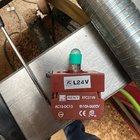Within 6 months of purchase in 2018, the green\red on\off switch went bad - red always turns machine off, but green button wouldn't work, intermittently at first but progressively worse until the lathe was unusable. Powermatic sent a replacement that I installed and it worked fine for a month or two but then failed in the same way. The next replacement they sent was clearly a different brand and it worked for over 3 years. But in the last few months, it too is going bad. Throughout all this, opening up the switch box and using compressed air to clean out any dust and debris, tightening screws (which were never noticeably loose), etc. doesn't fix it.
Currently, I can still usually get it to go on by letting the magnet "snap" the unit back up against the lathe a time or two and pressing green button.
What is new this time is that the reverse button has also started to fail - it will stop working for a week or two then come back to life, but it hasn't worked now for over a month.
I'm planning to order another replacement on/off switch, but the fact that my reverse button doesn't work makes me wonder if there is something else going on?
Anyone else experiencing problems with the 3520C switches? A neighbor of mine has had similar issues but we haven't heard much of anything else about it on forums and the like.
Currently, I can still usually get it to go on by letting the magnet "snap" the unit back up against the lathe a time or two and pressing green button.
What is new this time is that the reverse button has also started to fail - it will stop working for a week or two then come back to life, but it hasn't worked now for over a month.
I'm planning to order another replacement on/off switch, but the fact that my reverse button doesn't work makes me wonder if there is something else going on?
Anyone else experiencing problems with the 3520C switches? A neighbor of mine has had similar issues but we haven't heard much of anything else about it on forums and the like.

